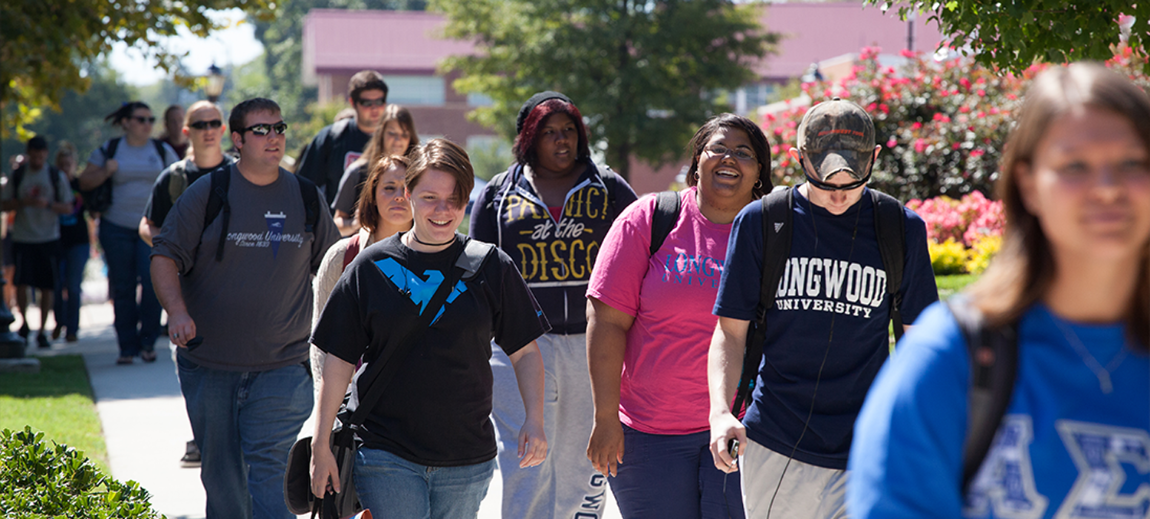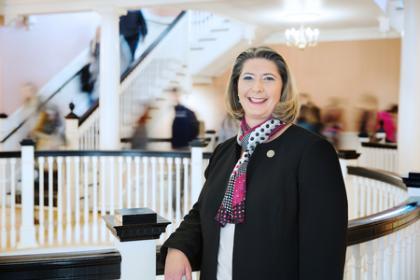

Over the last five years, Longwood’s freshman class has hovered around 1,100 students, and this year is likely to continue the trend. Bold new initiatives and a fresh approach to telling the Longwood story coupled with the allure of participating in the historic 2016 U.S. Vice Presidential debate have pushed applications to record levels, making the incoming class of 2020 the most talented and diverse in Longwood’s rich history.
Dr. Jennifer Green, associate vice president for enrollment management and student success, sat down to talk about Longwood’s incoming class and how the university is attracting more students with its unique and compelling story.
Our applicant pool has risen dramatically.
Yes, we’re going to land somewhere in the neighborhood of a 10 percent increase in the number of applicants over last year. In the last three years, applications to Longwood have increased by 26 percent—that’s just for incoming freshmen, not including transfer students. We just surpassed 5,000 freshmen applications for the first time in Longwood’s history. One of the things we’re most excited about is we’ve seen about a 30 percent jump in students who enroll with a high school GPA above 3.0—which means we are bringing in one of the most accomplished freshman classes in the history of our institution.
That’s a significant jump. Can we attribute it to actions our admissions department has taken?
We began to modify our strategy two years ago knowing that we wouldn’t begin see results until this year. In short, we started casting a wider net earlier in a high-school student’s career, communicating more strategically with the sophomores and juniors who are now seniors and looking at college. We are introducing them to the Longwood story earlier on, which has helped us build the applicant pool both in and out of state. One of the other tweaks we made is shifting our application deadline back from March 1 to Feb. 1, which is where most of the other four-year colleges are, so we are on the minds of students and counselors when they are in the midst of the process.
What kind of students are making up this increase?
One of the pieces that’s gone into this effort is figuring out the type of student who does really well at Longwood—by that I mean students who are happy, engaged and graduate on time. We’ve been able over the past few years to introduce Longwood to those students who are a good match, and we’ve seen a substantial increase in those pockets—not only in applications but subsequently in admitted and enrolled students. What we’ve achieved is not only the largest applicant pool in history but also the most diverse and talented, which is a strong combination.
Can you explain how we are leveraging our analytic capabilities to help drive growth?
 Our model tries to understand which students are the best fit for Longwood—not only the likelihood that they will enroll but also the likelihood they will graduate. We look at dozens of factors—high-school GPA being just one—and we are starting to do some qualitative analysis to see if we can find any other factors that are indicative of long-term success. For instance, a very preliminary analysis shows that students who use positive words or display a positive outlook in their application essay tend to stay in college longer than those who don’t.
Our model tries to understand which students are the best fit for Longwood—not only the likelihood that they will enroll but also the likelihood they will graduate. We look at dozens of factors—high-school GPA being just one—and we are starting to do some qualitative analysis to see if we can find any other factors that are indicative of long-term success. For instance, a very preliminary analysis shows that students who use positive words or display a positive outlook in their application essay tend to stay in college longer than those who don’t.
So we’re using all of these factors to identify students we want to communicate with in their sophomore and junior years, with the goal of helping them make the decision to choose Longwood if it’s right for them.
One key piece to all of this is that I don’t want to bring somebody here who isn’t going to be happy and successful here. It’s not about getting as many freshmen as we can and then letting them fall by the wayside. It’s about getting students who are going to be successful here—that helps both the student and us.
What exactly are we doing to connect with students in their sophomore and junior years?
First, we’re working more directly with counselors in their home schools, sharing with them the type of student who fits with Longwood so they can advise their students appropriately.
On the individual student level, we’re sharing more about the Longwood story and finding that it’s really attractive to potential students. Our narrative has shifted in all of our marketing pieces to a better reflection of the things that make our story unique: our top-notch academics, the remarkable camaraderie, the unique history, the abundant energy on campus. And that shift has led to the increase in students accepting our offer of admissions because everything we do is infused with that narrative.
For example, our admittance letter is not what I consider a typical admittance letter—it’s a piece designed to get that student to enroll at Longwood. It really describes what Longwood is and shares in the excitement of becoming a Lancer. We follow up with only the things students need to know to get to the next step, instead of the usual bombardment of information. That’s even reflected in our denial letter. We give freshmen who don’t get in on their first try an opportunity to let us know they are still interested in joining the Longwood family so we can play an advisory role in their journey toward successfully matriculating in the future.
"What we’ve achieved is not only the largest applicant pool in history but also the most diverse and talented."
Dr. Jennifer Green
Another key point to make is that we’ve focused on building campus visits into our application process. Our analytics show that students who enroll at Longwood without visiting have a lower retention rate, so we’re trying to work on getting our incoming freshmen here before move-in day. It’s a little like knowing who you are going to marry—you have to get that special feeling when you walk on campus.
How has the vice presidential debate factored into the increase in applications?
Other debate host sites have reported that their admissions numbers increased the year the actual debate happens. For us, that would be the next cycle. But we may be the only university that has infused all of our admissions materials with the debate from the outset—it’s solidly in our admissions letter and in all of our marketing materials. So I think it’s driving both applications and enrollment. Students want to be a part of it—we’ve already seen a major increase in incoming political science and history majors, which is clearly attributable to the debate. It’s hard to quantify at this point, but all of our efforts coupled with the debate have really positioned us nicely.
What are our overall goals? Where are we going?
We have outlined roughly a 3 percent annual growth for freshmen and transfer students coupled with a growth in retention figures—that’s doing it the right way. We’ve eyed an enrollment of about 6,000 undergraduate and graduate students, but we want to make sure we are growing toward that number in a sustainable and ethical way, not just admitting as many freshmen as we can. We’re committed to keeping the freshman class at about 1,100 while growing through retention and expanded graduate programs. Getting there the right way will make Longwood a stronger place into the future.

Leave a Comment